Electricity Consumption Forecasting using Support Vector Regression with the Mixture Maximum Correntropy Criterion
Abstract
:1. Introduction
1.1. Motivation
1.2. Literature Review
1.3. Our Contribution
1.4. Organization of the Paper
2. Methodology
2.1. SVR
2.2. Mixture Maximum Correntropy Criterion
3. SVR with MMCC
4. Electricity Consumption Forecasting Based on MMCCSVR
4.1. Characteristic Analysis of Electricity Consumption Data
4.2. Data Preprocessing
4.3. Parameter Optimization
4.4. Model Implementation
4.5. Evaluation Criterion
5. Results
5.1. Parameters Selection
5.2. Comparison of the Forecast Results Obtained with Different Inputs
5.3. Comparison of Different Forecasting Methods
6. Conclusions
- (1)
- Compared with the single-input MMCCSVR prediction model, the single-point prediction accuracy was effectively improved, and the average relative error was reduced.
- (2)
- Compared with the traditional SVR and other algorithms, the prediction errors of peak and valley values of EC were improved effectively.
- (3)
- The prediction error MAPE of this model was 1.79% and met the assessment criteria of power deviation in the location of the shopping mall and the prediction accuracy requirement of the power sales company.
Author Contributions
Funding
Conflicts of Interest
References
- Cao, Y.K.; Shuai, H. Medium and long-term load forecasting based on multi-factors modified PSO-SVM algorithm. Electronics, electrical engineering and information science. In Proceedings of the 2015 International Conference on Electronics, Electrical Engineering and Information Science (EEEIS2015), Guangzhou, China, 7–8 August 2015; pp. 682–693. [Google Scholar]
- Niu, D.X.; Ma, T.N.; Liu, B.Y. Power load forecasting by wavelet least squares support vector machine with improved fruit fly optimization algorithm. J. Comb. Optim. 2017, 33, 1122–1143. [Google Scholar]
- Sadaei, H.J.; Guimarães, F.G.; da Silva, C.J. Short-term load forecasting method based on fuzzy time series, seasonality and long memory process. Int. J. Approx. Reason. 2017, 83, 196–217. [Google Scholar] [CrossRef]
- Zhao, H.; Guo, S. An optimized grey model for annual power load forecasting. Energy 2016, 107, 272–286. [Google Scholar] [CrossRef]
- Hu, R.; Wen, S.; Zeng, Z. A short-term power load forecasting model based on the generalized regression neural network with decreasing step fruit fly optimization algorithm. Neurocomputing 2017, 221, 24–31. [Google Scholar] [CrossRef]
- Li, Y.; Che, J.; Yang, Y. Subsampled support vector regression ensemble for short term electric load forecasting. Energy 2018, 164, 160–170. [Google Scholar] [CrossRef]
- Yang, Y.; Che, J.; Deng, C. Sequential grid approach based support vector regression for short-term electric load forecasting. Appl. Energy 2019, 238, 1010–1021. [Google Scholar] [CrossRef]
- Dong, Y.; Zhang, Z.; Hong, W. A hybrid seasonal mechanism with a chaotic cuckoo search algorithm with a support vector regression model for electric load forecasting. Energy 2018, 11, 1009. [Google Scholar] [CrossRef]
- Hong, W.; Li, M.; Geng, J. Novel chaotic bat algorithm for forecasting complex motion of floating platforms. Appl. Math. Model. 2019, 72, 425–443. [Google Scholar] [CrossRef]
- Zhong, H.; Wang, J.; Jia, H. Vector field-based support vector regression for building energy consumption prediction. Appl. Energy 2019, 242, 403–414. [Google Scholar] [CrossRef]
- Liu, W.F.; Pokharel, P.P.; Principe, J.C. Correntropy: Properties and applications in non-Gaussian signal processing. IEEE Trans. Signal Process. 2007, 55, 5286–5298. [Google Scholar] [CrossRef]
- Chen, B.D.; Xing, L.; Zhao, H.; Zheng, N.; Principe, J.C. generalized correntropy for robust adaptive filtering. IEEE Trans. Signal Process. 2016, 64, 3376–3387. [Google Scholar] [CrossRef]
- Ma, W.; Chen, B.; Duan, J. Diffusion maximum correntropy criterion algorithms for robust distributed estimation. Digit. Signal Process. 2016, 58, 10–19. [Google Scholar] [CrossRef] [Green Version]
- Wu, Z.; Shi, J.; Zhang, X. Kernel recursive maximum correntropy. Signal Process. 2015, 117, 11–16. [Google Scholar] [CrossRef]
- Ma, W.; Qu, H.; Gui, G. Maximum correntropy criterion based sparse adaptive filtering algorithms for robust channel estimation under non-Gaussian environments. J. Franklin Inst. 2015, 352, 2708–2727. [Google Scholar] [CrossRef] [Green Version]
- Qian, G.; Wang, S. Generalized complex correntropy: Application to adaptive filtering of complex data. IEEE Access. 2018, 6, 19113–19120. [Google Scholar] [CrossRef]
- Loza, C.A.; Principe, J.C. Generalized correntropy matching pursuit: A novel, robust algorithm for sparse decomposition. In Proceedings of the International Joint Conference on Neural Networks (IJCNN), Vancouver, Canada, 25–29 July 2016; pp. 1723–1727. [Google Scholar]
- Luo, X.; Sun, J.; Wang, L. Short-term wind speed forecasting via stacked extreme learning machine with generalized correntropy. IEEE Trans. Ind. Inform. 2018, 14, 4963–4971. [Google Scholar] [CrossRef]
- Chen, B.; Ma, R.; Yu, S. Granger causality analysis based on quantized minimum error entropy criterion. IEEE Signal Process. Lett. 2019, 26, 347–351. [Google Scholar] [CrossRef]
- Wang, S.; Dang, L.; Chen, B. Random Fourier filters under maximum correntropy criterion. IEEE Trans. Circuits I 2018, 65, 3390–3403. [Google Scholar] [CrossRef]
- Hou, B.; He, Z.; Zhou, X. Maximum correntropy criterion kalman filter for α-jerk tracking model with non-gaussian noise. Entropy 2017, 19, 648. [Google Scholar] [CrossRef]
- Ma, W.; Zheng, D.; Zhang, Z. Sparse-aware bias-compensated adaptive filtering algorithms using the maximum correntropy criterion for sparse system identification with noisy input. Entropy 2018, 20, 407. [Google Scholar] [CrossRef]
- Zhou, N.; Xu, Y.; Cheng, H. Maximum correntropy criterion based sparse subspace learning for unsupervised feature selection. IEEE Trans. Circuits Syst. Video 2017, 99, 404–417. [Google Scholar] [CrossRef]
- Wang, Y.; Li, Y.; Albu, F. Group-constrained maximum correntropy criterion algorithms for estimating sparse mix-noised channels. Entropy 2017, 19, 432. [Google Scholar] [CrossRef]
- Wu, Z.; Peng, S.; Chen, B. Robust Hammerstein adaptive filtering under maximum correntropy criterion. Entropy Switz. 2015, 17, 7149–7166. [Google Scholar] [CrossRef]
- Chen, B.; Wang, X.; Lu, N. Mixture correntropy for robust learning. Pattern Recognit. 2018, 79, 318–327. [Google Scholar] [CrossRef]
- Brereton, R.G.; Lloyd, G.R. Support vector machines for classification and regression. Analyst 2010, 135, 230–267. [Google Scholar] [CrossRef]
- He, R.; Hu, B.G.; Zhang, W.S. Robust principal component analysis based on maximum correntropy criterion. IEEE Trans. Image Process. 2011, 20, 1485–1494. [Google Scholar]
- He, R.; Zheng, W.S.; Tan, T. Half-quadratic-based iterative minimization for robust sparse representation. IEEE Trans. Pattern Anal. 2013, 36, 261–275. [Google Scholar]
- Wang, Y.; Tang, Y.Y.; Li, L. Correntropy matching pursuit with application to robust digit and face recognition. IEEE Trans. Cybern. 2016, 47, 1354–1366. [Google Scholar] [CrossRef]
- Yan, H.; Yuan, X.; Yan, S. Correntropy based feature selection using binary projection. Pattern Recognit. 2011, 44, 2834–2842. [Google Scholar] [CrossRef]
- Boyd, S.; Vandenberghe, L. Convex Optimization; Cambridge University Press: Cambridge, UK, 2004. [Google Scholar]
- Ojeda, F.; Suykens, J.; Moor, B.D. Low rank updated LS-SVM classifiers for fast variable selection. Neural Netw. 2008, 21, 437–449. [Google Scholar] [CrossRef]
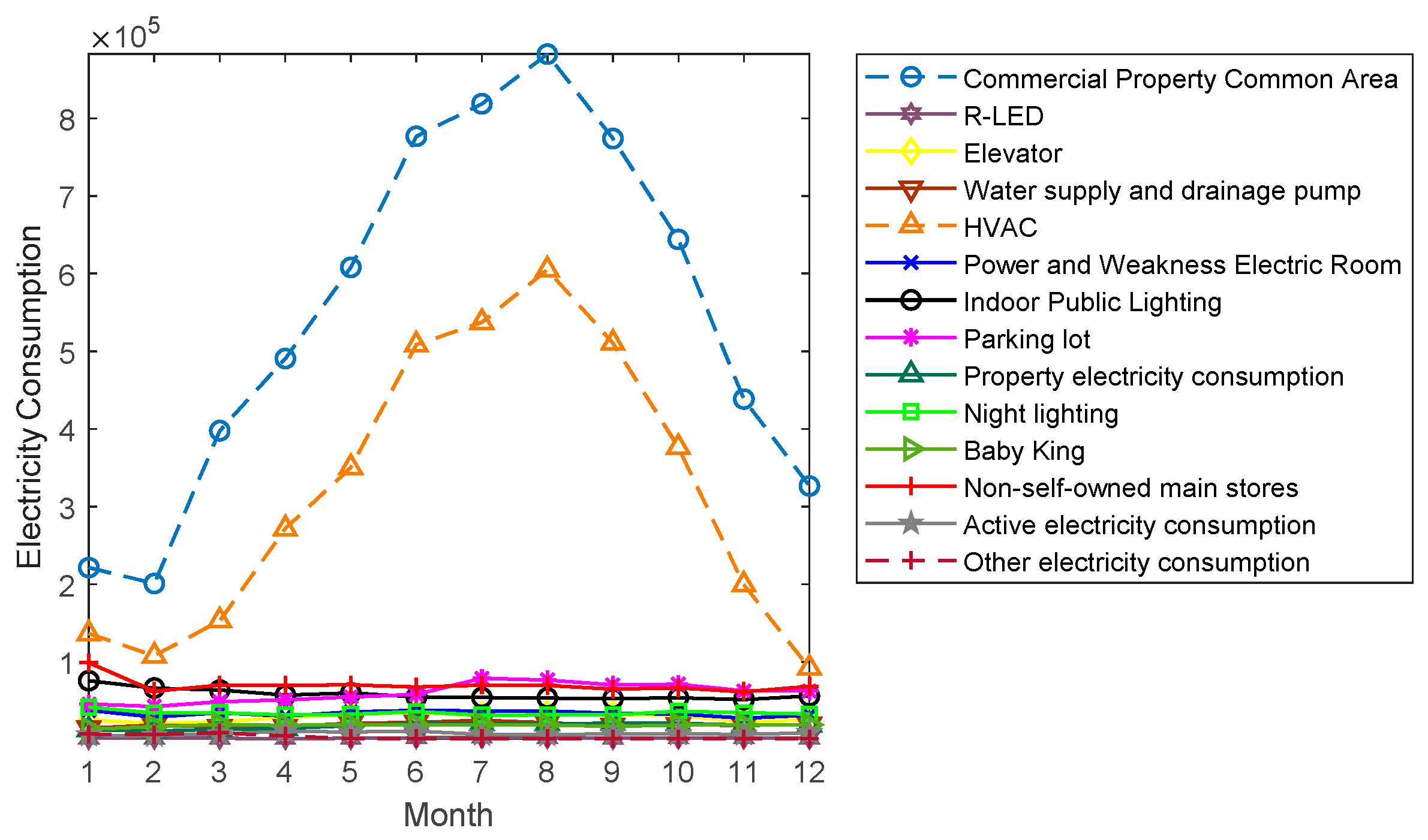

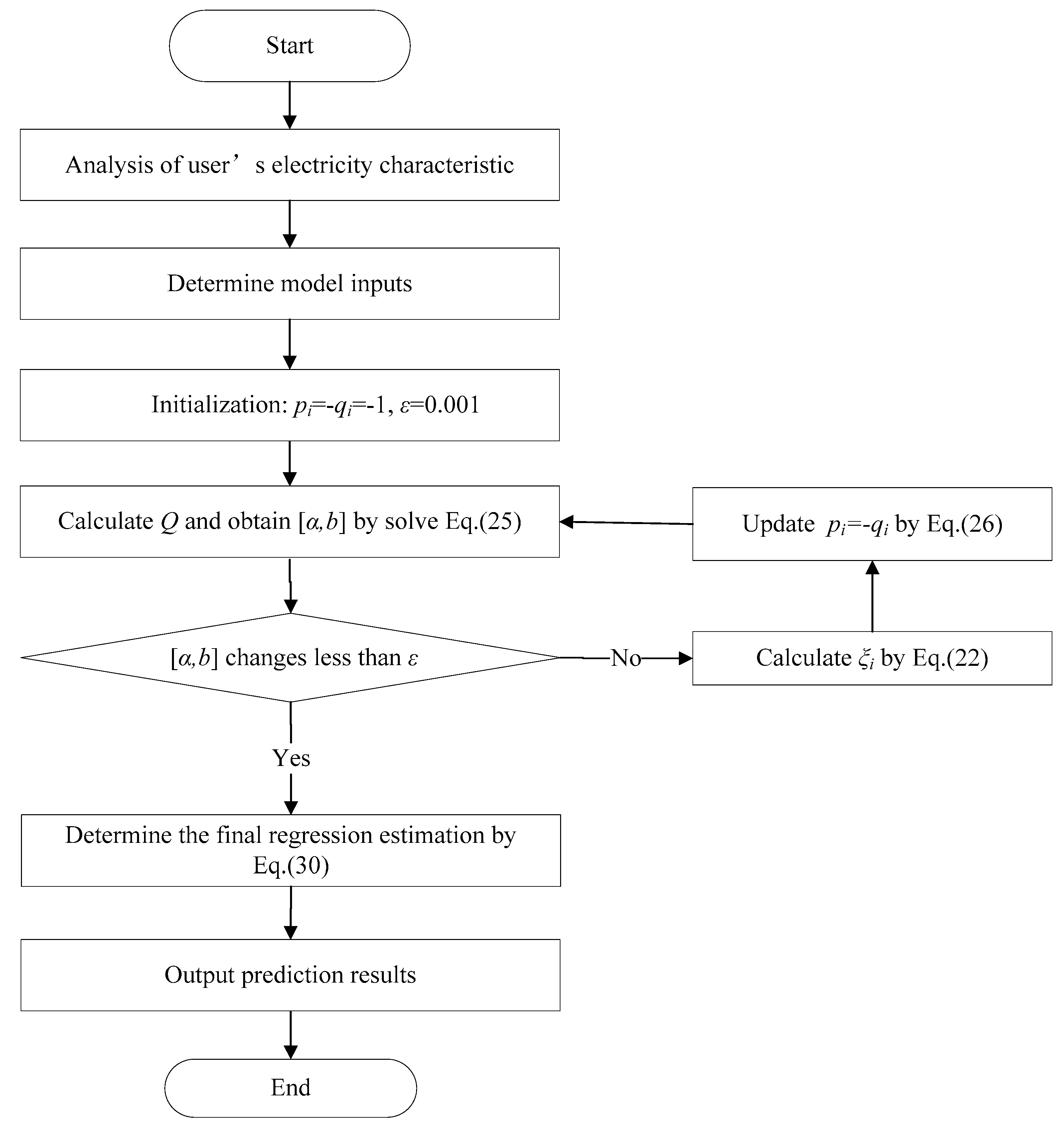
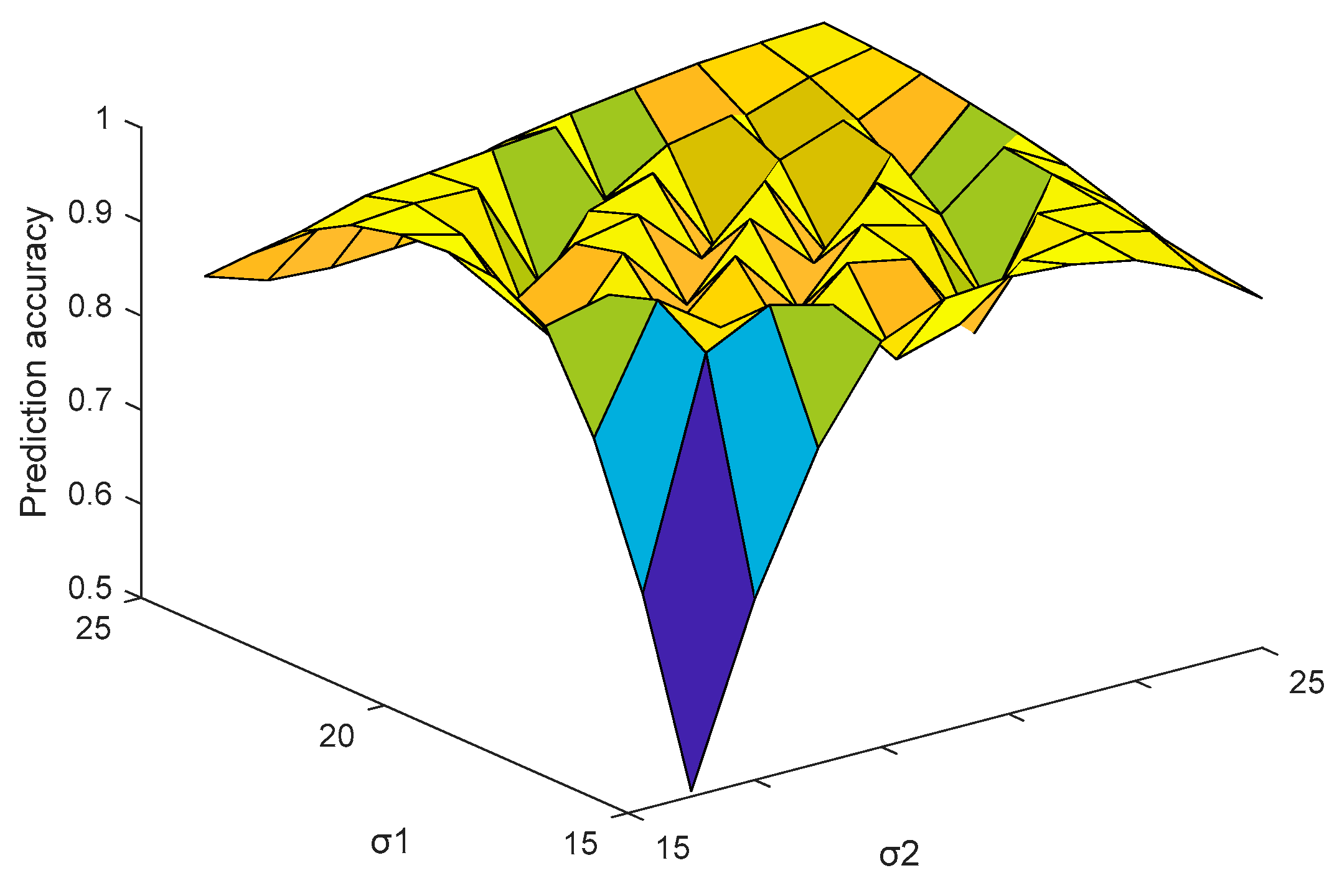

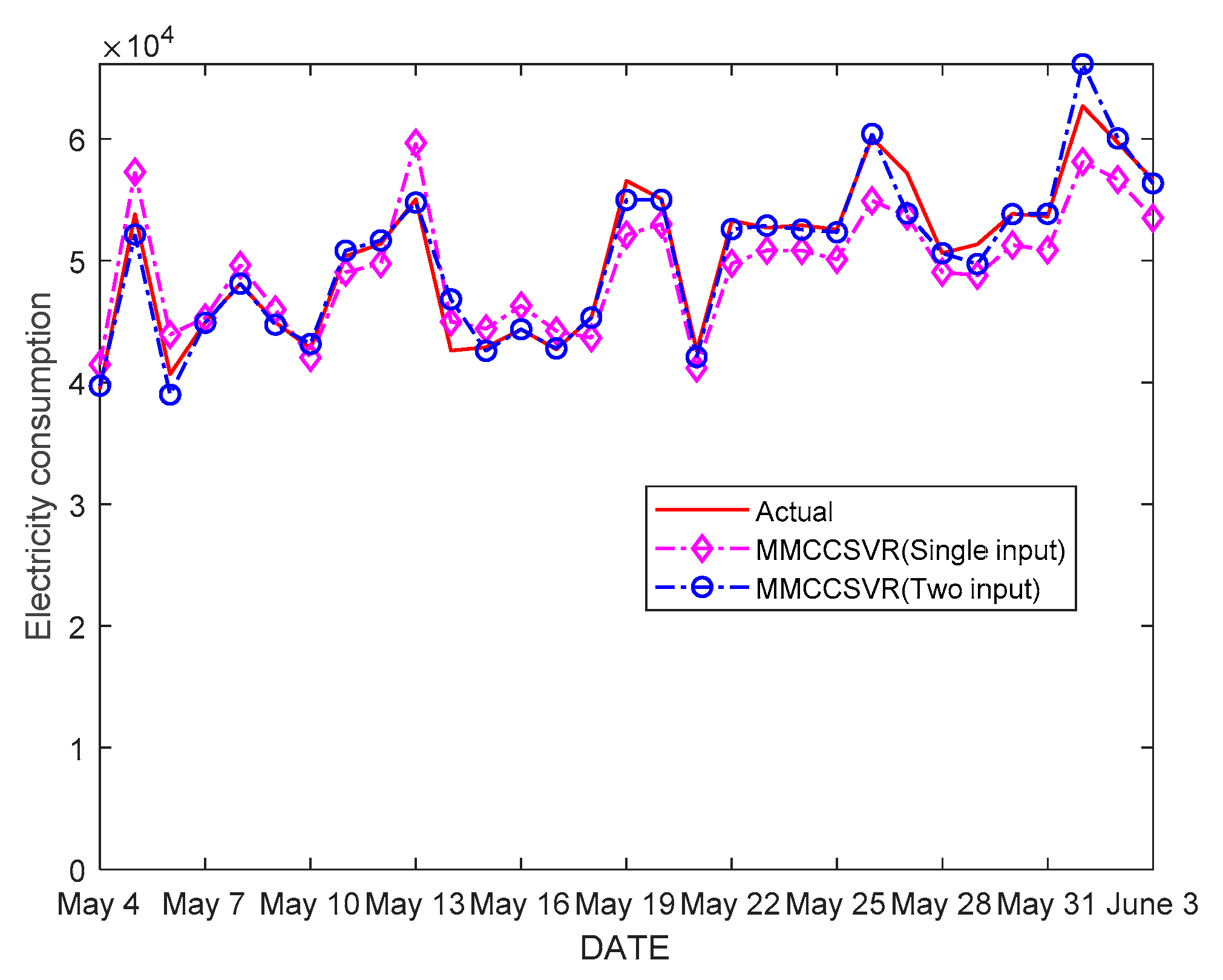
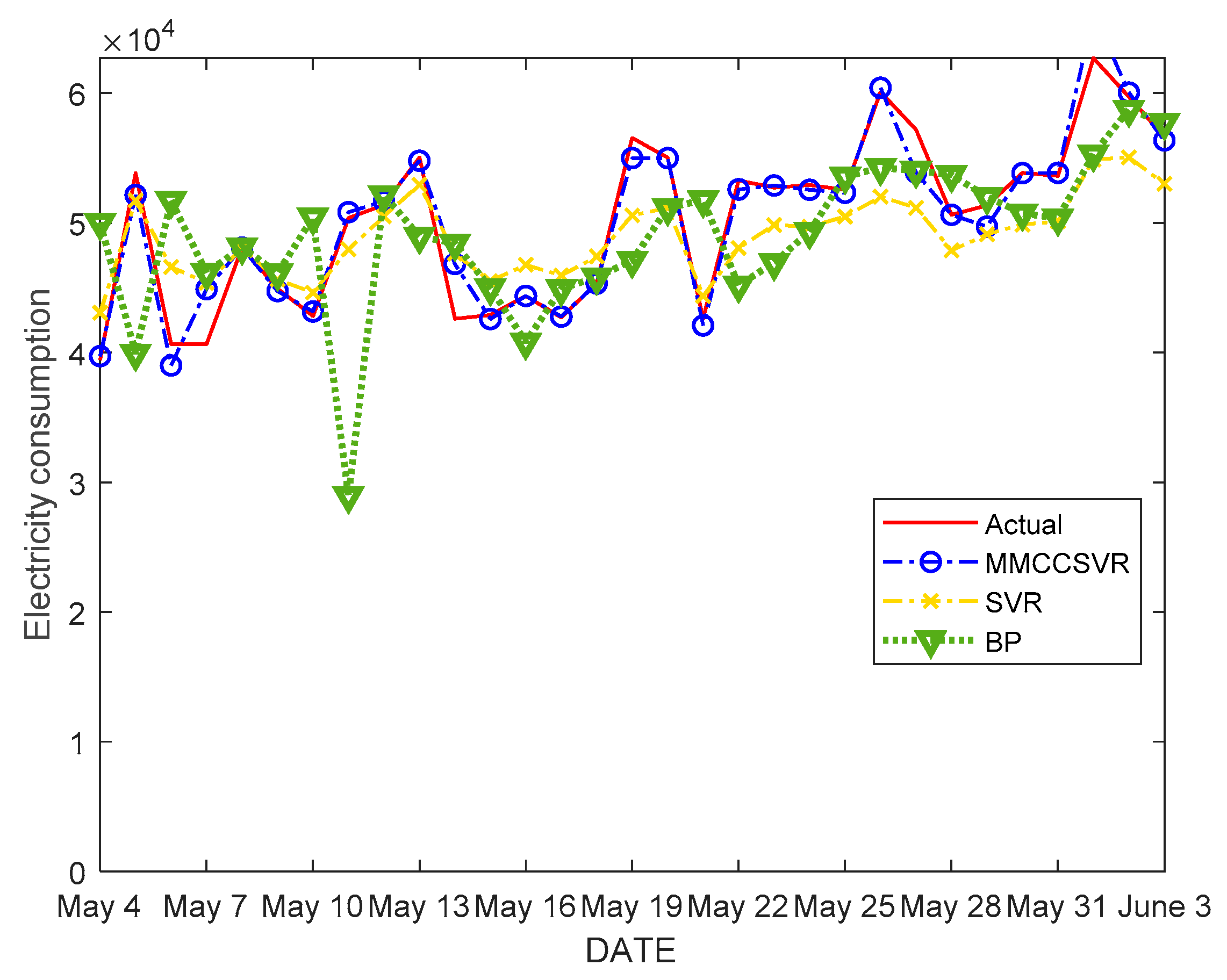
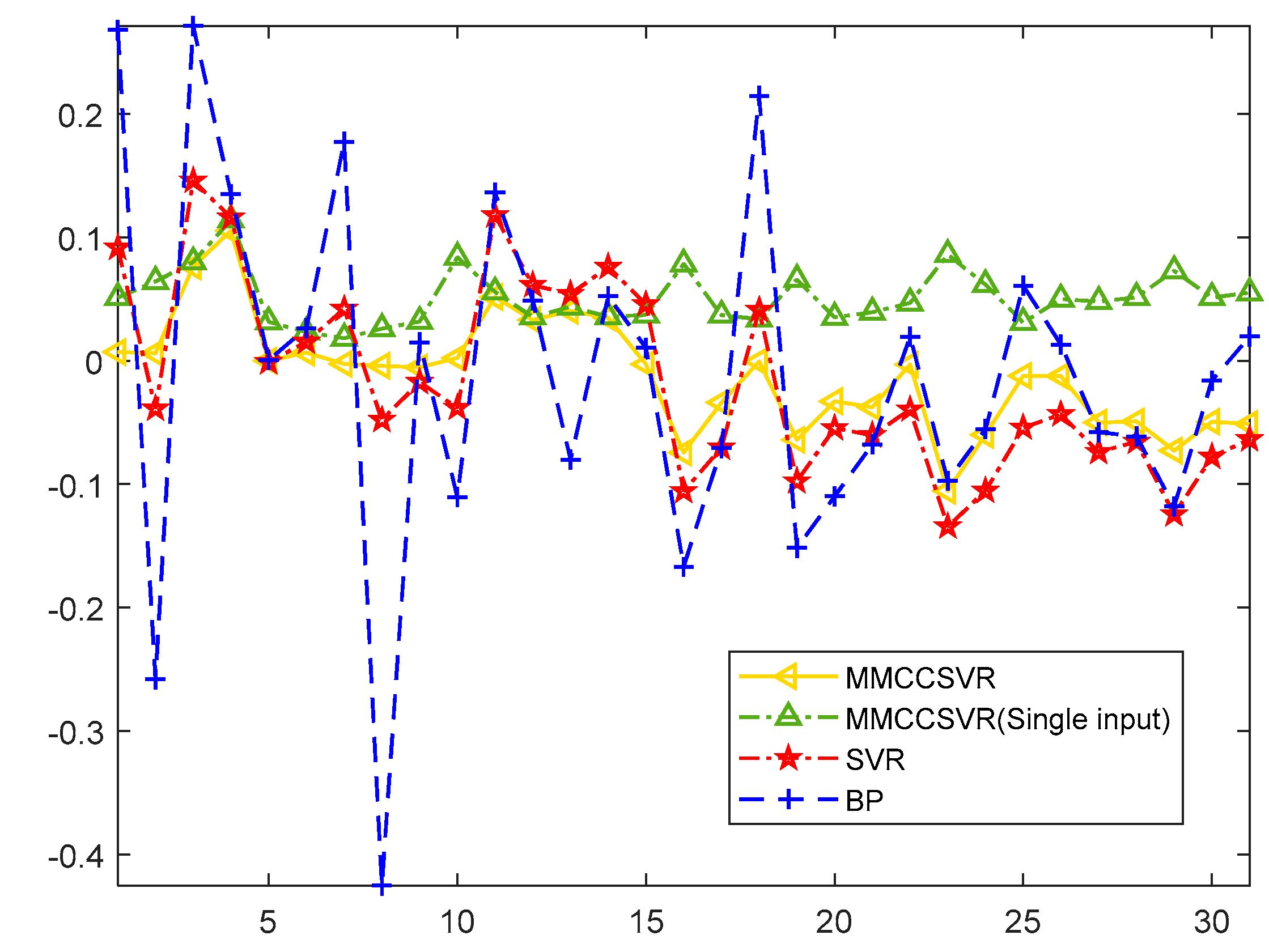
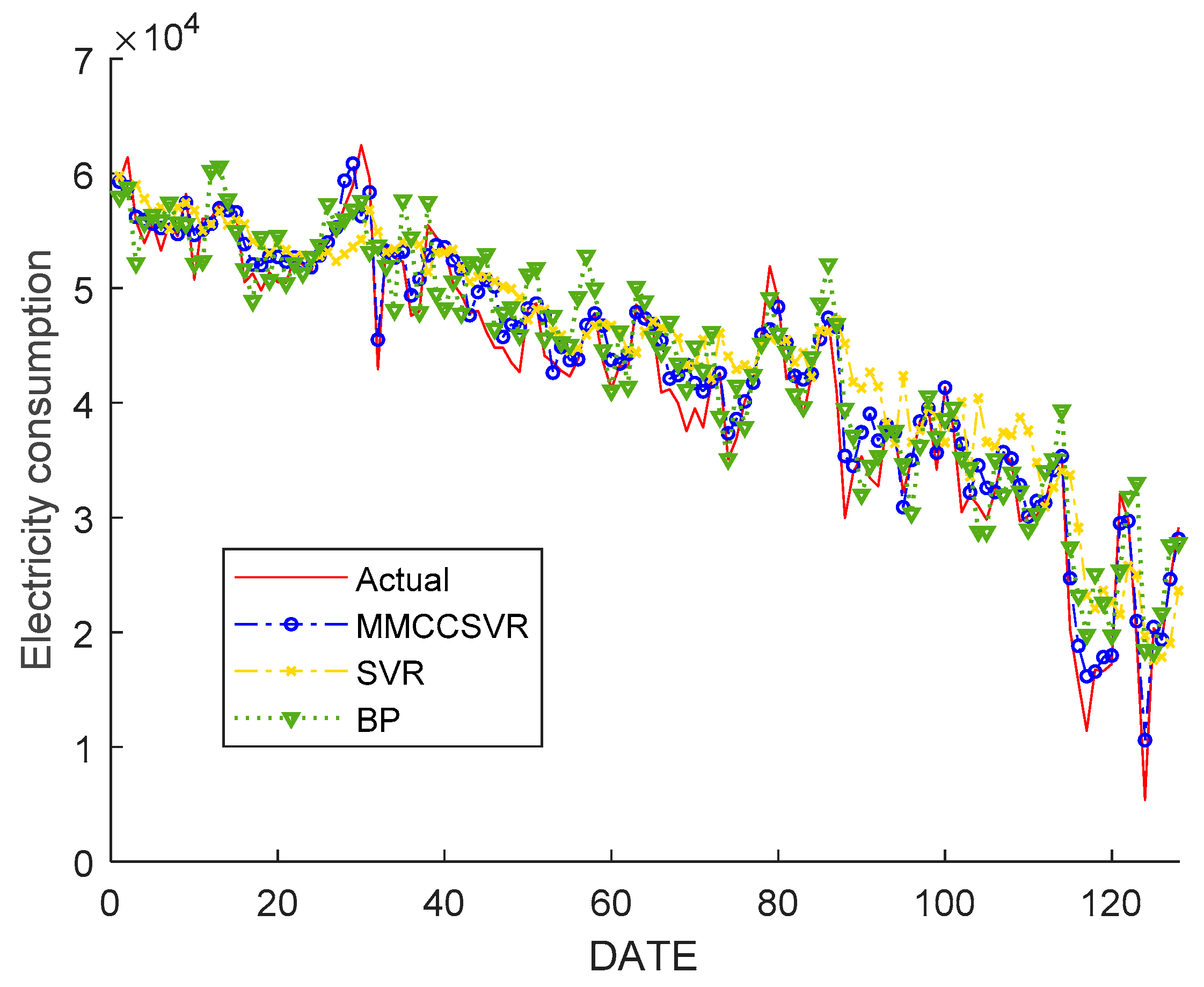
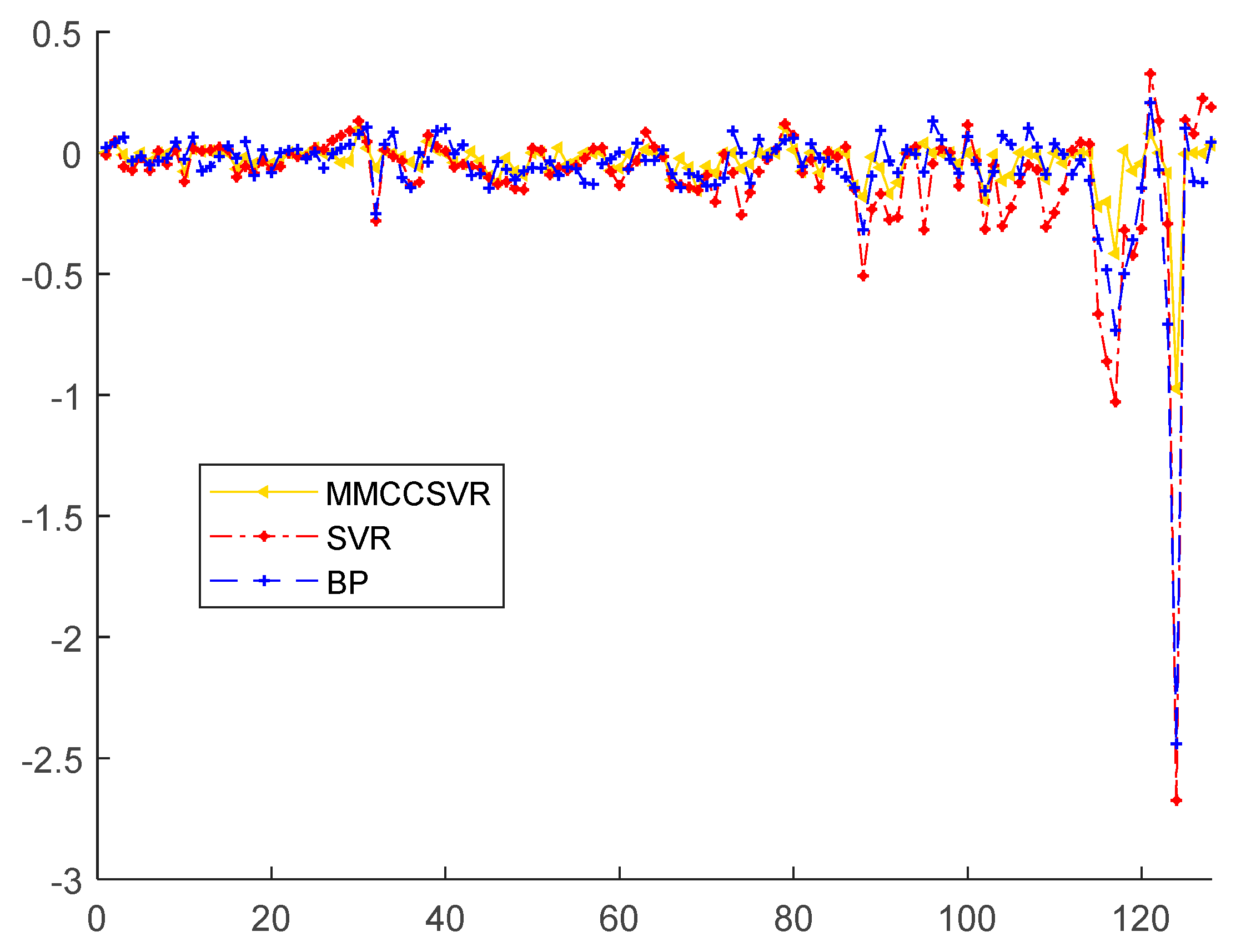
| 15 | 16 | 17 | 18 | 19 | 20 | 21 | 22 | 23 | 24 | 25 | |
| Prediction accuracy (%) | 50.5 | 69.2 | 83.6 | 93.2 | 96.0 | 98.2 | 96.1 | 94.8 | 91.8 | 87.2 | 82.4 |
| Day | Actual (kW·h) | Single Input (kW·h) | MAPE (%) | Two Input (kW·h) | MAPE (%) |
|---|---|---|---|---|---|
| 4 May | 39,442 | 41,463 | 5.12 | 397,19 | 0.70 |
| 5 May | 53,823 | 41,463 | 6.43 | 52,141 | −3.13 |
| 6 May | 40,666 | 57,283 | 8.01 | 38,997 | −4.10 |
| 7 May | 40,666 | 43,925 | 11.41 | 44,889 | 10.38 |
| 8 May | 48,099 | 45,305 | 3.16 | 48,100 | 0.00 |
| 9 May | 44,929 | 49,621 | 2.32 | 44,735 | −0.43 |
| 10 May | 42,820 | 45,973 | −1.82 | 43,160 | 0.79 |
| 11 May | 50,363 | 42,039 | −2.60 | 50,820 | 0.91 |
| 12 May | 51,381 | 49,056 | −3.18 | 51,659 | 0.54 |
| 13 May | 55,039 | 59,663 | 8.40 | 54,774 | −0.48 |
| 14 May | 42,610 | 44,984 | 5.57 | 46,824 | 9.89 |
| 15 May | 42,886 | 44,408 | 3.55 | 42,586 | −0.70 |
| 16 May | 44,358 | 46,295 | 4.37 | 44,364 | 0.01 |
| 17 May | 42,699 | 44,224 | 3.57 | 42,777 | 0.18 |
| 18 May | 45,329 | 43,647 | −3.71 | 45,329 | 0.00 |
| 19 May | 56,549 | 52,112 | −7.85 | 54,990 | −2.76 |
| 20 May | 55,039 | 53,006 | −3.69 | 54,984 | −0.10 |
| 21 May | 42,610 | 41,170 | −3.38 | 42,090 | −1.22 |
| 22 May | 53,268 | 49,759 | −6.59 | 52,574 | −1.30 |
| 23 May | 52,707 | 50,851 | −3.52 | 52,874 | 0.32 |
| 24 May | 52,913 | 50,834 | −3.93 | 52,546 | −0.69 |
| 25 May | 52,547 | 50,085 | −4.69 | 52,329 | −0.41 |
| 26 May | 60,092 | 54,925 | −8.60 | 60,408 | 0.53 |
| 27 May | 57,188 | 53,659 | −6.17 | 53,875 | −5.79 |
| 28 May | 50,614 | 49,047 | −3.10 | 50,614 | 0.00 |
| 29 May | 51,341 | 48,776 | −5.00 | 49,713 | −3.17 |
| 30 May | 53,857 | 51,274 | −4.80 | 53,825 | −0.06 |
| 31 May | 53,620 | 50,864 | −5.14 | 53,849 | 0.43 |
| 1 June | 62,691 | 58,118 | −7.29 | 66,143 | 5.51 |
| 2 June | 59,699 | 56,645 | −5.12 | 60,045 | 0.58 |
| 3 June | 56,619 | 53,493 | −5.52 | 56,348 | −0.48 |
| MAPE | 5.08% | 1.79% | |||
| Day | MMCCSVR | SVR | BP |
|---|---|---|---|
| 4 May | 0.70 | 9.17 | 26.81 |
| 5 May | −3.13 | −3.88 | −25.81 |
| 6 May | −4.10 | 14.59 | 27.14 |
| 7 May | 10.38 | 11.60 | 13.49 |
| 8 May | 0.00 | −0.12 | 0.06 |
| 9 May | −0.43 | 1.54 | 2.64 |
| 10 May | 0.79 | 4.21 | 17.74 |
| 11 May | 0.91 | −4.80 | −42.53 |
| 12 May | 0.54 | −1.73 | 1.49 |
| 13 May | −0.48 | −3.81 | −11.05 |
| 14 May | 9.89 | 11.78 | 13.64 |
| 15 May | −0.70 | 6.12 | 4.89 |
| 16 May | 0.01 | 5.42 | −8.01 |
| 17 May | 0.18 | 7.59 | 5.22 |
| 18 May | 0.00 | 4.58 | 1.04 |
| 19 May | −2.76 | −10.57 | −16.71 |
| 20 May | −0.10 | −7.06 | −7.08 |
| 21 May | −1.22 | 4.11 | 21.46 |
| 22 May | −1.30 | −9.77 | −15.16 |
| 23 May | 0.32 | −5.46 | −10.99 |
| 24 May | −0.69 | −6.04 | −6.78 |
| 25 May | −0.41 | −3.94 | 1.95 |
| 26 May | 0.53 | −13.44 | −9.73 |
| 27 May | −5.79 | −10.54 | −5.53 |
| 28 May | 0.00 | −5.42 | 6.09 |
| 29 May | −3.17 | −4.34 | 1.30 |
| 30 May | −0.06 | −7.40 | −5.79 |
| 31 May | 0.43 | −6.56 | −6.13 |
| 1 June | 5.51 | −12.45 | −11.81 |
| 2 June | 0.58 | −7.79 | −1.61 |
| 3 June | −0.48 | −6.56 | 1.96 |
| MAPE | 1.79% | 6.84% | 10.70% |
| Method | MAPE | MAE | RMSE | R2 |
|---|---|---|---|---|
| MMCCSVR | 1.79% | 875.8387 | 1515.228 | 0.9781 |
| MMCCSVR (Single Input) | 5.08% | 2582.8387 | 2836.0348 | 0.9150 |
| SVR | 6.84% | 3460.8710 | 3951.0136 | 0.9304 |
| BP | 10.70% | 5220.8065 | 6957.5602 | 0.3541 |
| Method | MAPE | MAE | RMSE | R2 |
|---|---|---|---|---|
| MMCCSVR | 3.86% | 1528.2 | 2289.7 | 0.9846 |
| SVR | 13.78% | 3966.4375 | 6180.0521 | 0.9173 |
| BP | 10.43% | 3123.5748 | 3978.9582 | 0.9481 |
© 2019 by the authors. Licensee MDPI, Basel, Switzerland. This article is an open access article distributed under the terms and conditions of the Creative Commons Attribution (CC BY) license (http://creativecommons.org/licenses/by/4.0/).
Share and Cite
Duan, J.; Tian, X.; Ma, W.; Qiu, X.; Wang, P.; An, L. Electricity Consumption Forecasting using Support Vector Regression with the Mixture Maximum Correntropy Criterion. Entropy 2019, 21, 707. https://doi.org/10.3390/e21070707
Duan J, Tian X, Ma W, Qiu X, Wang P, An L. Electricity Consumption Forecasting using Support Vector Regression with the Mixture Maximum Correntropy Criterion. Entropy. 2019; 21(7):707. https://doi.org/10.3390/e21070707
Chicago/Turabian StyleDuan, Jiandong, Xuan Tian, Wentao Ma, Xinyu Qiu, Peng Wang, and Lin An. 2019. "Electricity Consumption Forecasting using Support Vector Regression with the Mixture Maximum Correntropy Criterion" Entropy 21, no. 7: 707. https://doi.org/10.3390/e21070707
APA StyleDuan, J., Tian, X., Ma, W., Qiu, X., Wang, P., & An, L. (2019). Electricity Consumption Forecasting using Support Vector Regression with the Mixture Maximum Correntropy Criterion. Entropy, 21(7), 707. https://doi.org/10.3390/e21070707





